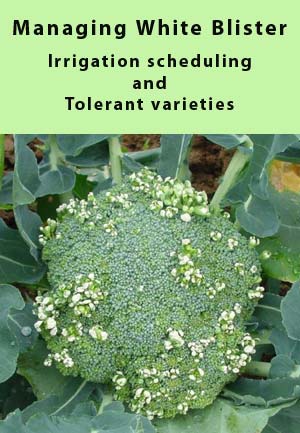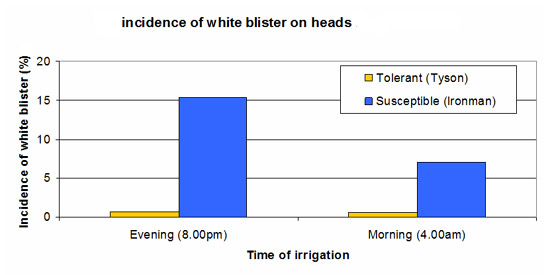|
|
This study was conducted as part of HAL project VG07070, to investigated the effect of irrigation timing on the incidence of white blister disease (Albugo candida) on broccoli. The incidence of white blister on broccoli heads could be halved in overhead irrigated crops watered at dawn (4am) rather than in the evening (8pm). Watering at dawn matches the natural ‘morning dew’ period. Leaves wet in the morning have several hours to dry during the day while, with evening irrigation, leaves may stay wet for a longer period which promotes disease development.. An economic analysis showed that irrigating at dawn improved farm profit by up to 5%.
Irrigation : Watering at dawn coincides with the morning dew period. That means that leaves are only wet once in the day instead of twice with the afternoon or evening watering Leaves have several hours to dry during the warmer day temperatures with morning irrigation, whereas with evening irrigation leaves may stay wet for longer. The leaf surface needs to be wet for a period of three hours for the organism that causes white blister to infect and cause disease. The shorter the periods of leaf wetness, the lower the risk of infection. Irrigation scheduling is most critical during spring and autumn when climatic conditions are ideal for the disease. The benefits of timing irrigation scheduling as a tool to reduce white blister in the crops, applied equally to varieties which are both susceptible and currently tolerance to it.
Resistant varieties : Growing a broccoli variety tolerant to white blister reduced the disease on heads by 96% and increased profits by 22%. Unfortunately broccoli varieties tolerant to white blister are not available all year round. Young plant tissues were very susceptible to white blister, for example side shoots and buttons of broccoli. Growers should avoid growing varieties with prolific side shoots and protect young tissues with a registered fungicide. Acknowledgments : The authors wish to thank Boomaroo Nursery for supplying seedlings as well as Karl Riedel and David Milburn, for their agronomic advice. Funding was provided by Australian vegetable growers (through the R & D levy) and the Department of Primary Industries, Victoria. The Australian Government provides matched funding for all HAL’s R&D activities. |
||||||
|


